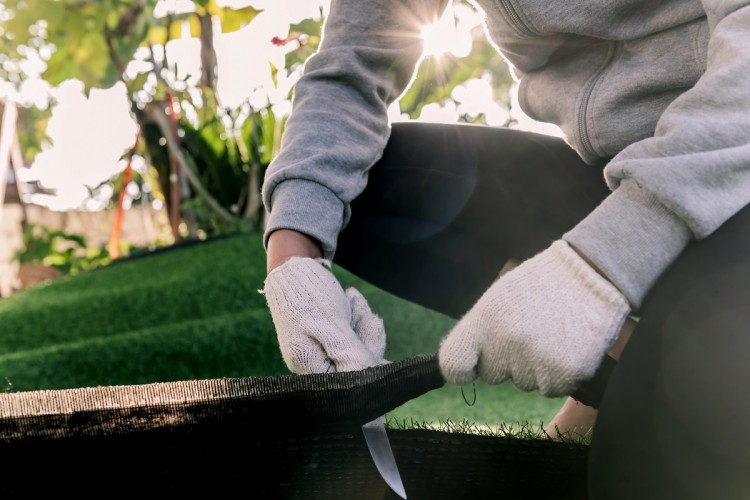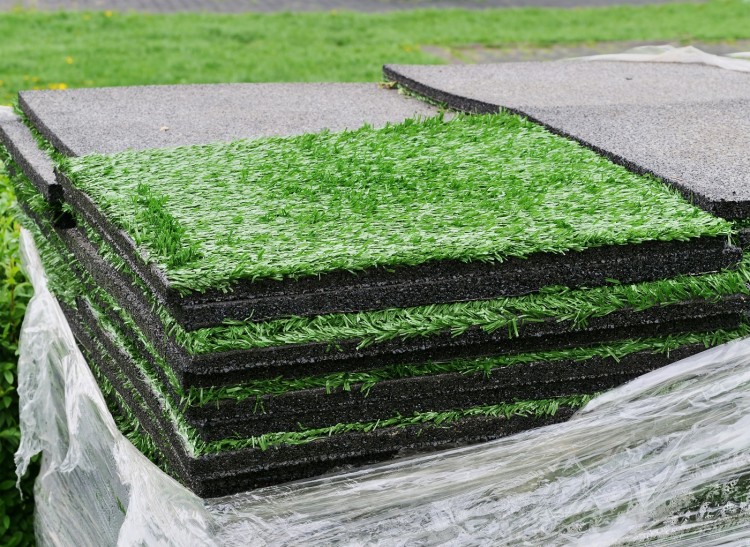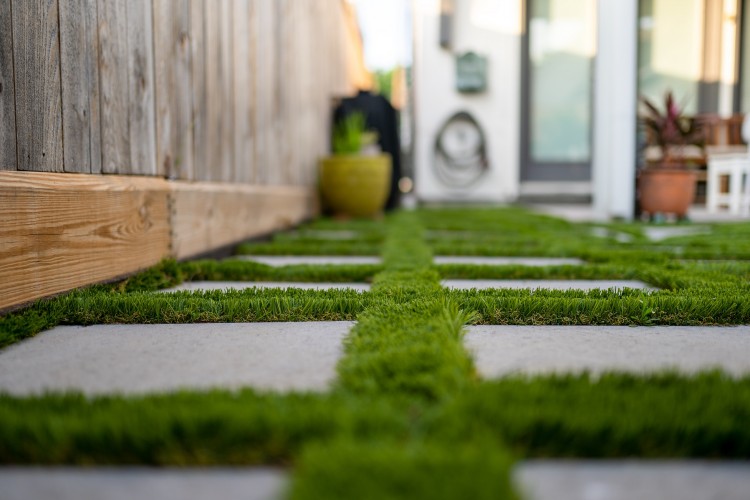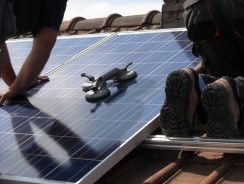
A well-maintained landscape can certainly spruce up the look of your property. Landscape features such as planting, shrubs, and patio grass are among the elements commonly found in a residential setting. Aside from helping improve the curb appeal, a good landscape also allows you to connect with nature.
However, a good landscape requires a lot of maintenance. For instance, your patio, to keep its charm, you must see to it that it receives regular upkeep and care. This can be a grueling chore, especially for people who don’t have time to spare. If that’s the case for you, then it may be time to consider investing in fake grass for patios.
What Is Fake Grass?
Fake grass is essentially artificial turf. It looks and tends to feel like real and natural grass since it has crimped and soft blades to touch. It is made from synthetic materials, which means that it can withstand extreme heat or cold without dying.
Since it is artificial, fake grass can give you that lush green lawn without requiring you to exert a lot of time and effort maintaining it.
What Are The Benefits Of Having Fake Grass?
Aside from revamping your landscape without the need for regular maintenance, fake grass has other benefits too.
- Kid-friendly (And Pets)
If you have a toddler or young children at the house, you might be worried about them playing on the lawn and possibly ingesting some of the grass or the fertilizers applied to them. With fake grass, you can cross that off from your worries. More so, fake grass is safe and durable, which can be a great playing ground for your little ones.
Or if you have a pet, a dog, for instance, who you are worried about spreading mud or dirt around the house after running or playing in the garden, then fake grass can be your option.
- Low Maintenance
As mentioned, maintaining a yard or patio with fake grass isn’t as demanding compared to one with natural grass.
Since it is made from synthetic materials, you wouldn’t need to water it or fertilize it. However, if you want to clean your artificial turf, you can easily and conveniently do so. To remove the accumulated dirt and grime, you can rinse or spray down the fake grass with a hose or use a broom with stiff bristles.
- Great For Any Type Of Weather
No matter what time of year it is or which part of the world you live in, artificial grass won’t die. Unlike natural grass, fake grass won’t require regular sun exposure for it to grow and flourish.

How Do I Buy Fake Grass?
Buying fake grass for patios is much easier than you may think. Many home and garden suppliers carry it, as do online retailers.
To help you start, here are some tips for finding the best deal on fake grass:
1. Research Online First
Before you head to the physical store, consider doing some research first to see what types of artificial grass are available in the market.
The most popular type of fake grass is the tufted type. This type has blades that are crimped in the sides, which gives off an appearance much like real grass. However, if you don’t fancy this type, you can opt for the endless loop turf. This type comes in a variety of materials, including recycled rubber and nylon. Endless loop turf is best for sports surfaces since they are durable and can withstand high traffic. Other than the tufted and endless loop turf, there’s also needle-punched grass, which is made with fibers combed in one direction.
Learning about the different types of artificial grass available in the market today can certainly go a long way in helping you make the right purchase. Researching and familiarizing yourself allows you to determine which fake grass is most compatible and suitable to your outdoor space’s requirements. Consider browsing suppliers’ websites for product details, rates and discounts, and package inclusions.
2. Compare Price & Quality
Now that you have adequate knowledge about fake grass, the cost and quality of the artificial turf come next.
As mentioned, you should always compare price and quality when shopping for artificial grass. Some of the good qualities of fake grass that you should look for are the ones that are made from polyethylene materials, have a high density, can withstand heavy foot traffic, are UV-stable, have low water absorption, and are resistant to damage caused by insects.
Using low-quality artificial grass may end up costing you more in the long run because it won’t last as long or even look as nice.
When comparing price and quality, the first thing you should look at is the type of grass: SDPE, Nylon, or WBPP. SDPE and WCBP are both more expensive than Nylon. However, 100% SDPE is sturdier than WCBP, so it’s a better option if you’re looking for something long-lasting.
3. Research On The Brand
When choosing a brand or supplier, aside from checking what type of fake grass they are offering, you must also check the reviews and feedbacks from actual customers. Doing so will allow you to know more about the quality of their product. The more positive reviews they have, the more you can be assured that their product is worth investing in.
Moreover, you should also ask or check the brand or supplier’s return policy or warranty. This can protect you in case there are issues with their product or if the quality of their product is subpar.
4. Purchase Grass By The Roll
When buying fake grass, you’ll get a much better deal by purchasing it by the roll rather than by square tiles. This will work, especially if you are planning to install it in a large area, such as your yard.
On the other hand, if you only need a small patch of synthetic grass for your patio, then square tiles can be your option. More so, fake grass tiles also work if your lawn is irregularly shaped.

How Do I Install Fake Grass?
Most suppliers typically offer installation services when they’re drafting your quotation or proposal. While this option can cost you more, opting for the supplier to install the fake grass on your property can help you save time.
On the other hand, if you prefer to install the artificial turf yourself, you may do so since this may help you save on costs. However, it’d be good to note that this can be a labor-intensive task that will require a lot of time and effort from your end. Moreover, the complexity of the installation process may depend on the type of fake grass you intend to use since not all have the same requirements.
To help you start, here are some installation tips to keep in mind.
- Level the base and prepare your lawn to make it look perfectly natural when you’re finished.
- You’ll need an infill substance to spread across the base of your lawn. This substance provides a natural look for your grass and prevents weeds from growing.
- Once your lawn’s ready to go, it’s time to unbox and lay down each roll. You’ll want to arrange them in a fan pattern as you put them out on the base. Try starting from the center and working your way out from there.
- After all of your grass is laid down, be sure to give it time to settle before adding the infill. Most types of grass will take between 24 and 72 hours to lay flat, so don’t rush the process.
Mistakes To Avoid When Installing Fake Grass
As easy as it may seem to install artificial grass, there are some mistakes that homeowners often make along the way. Here’s a list of common errors, along with how to avoid them:
1. Skipping The Base Layers
The base of your lawn is crucial for two reasons. Not only does it provide the foundation for your grass, but it also keeps it in place and prevents weeds from growing. If you skip this step, you’ll likely find yourself disappointed with the results.
2. Not Using A Barrier
If you’re using your fake grass on an area where water will be draining through it, then you should consider installing a barrier to protect the base of your lawn. It’s imperative if you live in an area that sees heavy rain or snowfall every year.
3. Choosing The Wrong Infill Substance For Your Climate
If you live in a city or region that sees heavy rain or snowfall every year, then choosing a substance that’s not waterproof could lead to major problems down the road. If you’re working with a landscaper to install your artificial grass, be sure to ask about what kind of infill substance will work best for your location and climate.
4. Forgetting To Add An Irrigation System
If you want your lawn to last a long time without needing major repairs, then you should consider installing an irrigation system. Doing this won’t only keep your lawn looking great but also protect the base from erosion and damage.

How To Maintain Artificial Grass
While it is true that fake grass requires little to no maintenance, it won’t hurt to do basic upkeep from time to time. Doing so can ensure that your patio stays looking great for as long as possible. That said, here are some tips for keeping your artificial grass looking great without too much effort.
1. Remove Stubborn Debris By Hand
If your lawn gets particularly dirty, then you might need to remove the debris by hand. A stiff bristle brush works best for this procedure, but you can also use a sponge if necessary.
2. Hose Off The Grass To Remove Debris
Aside from manually removing dirt and grime that may have accumulated over time by hand, you can also hose down your fake grass to quickly clean it off. This process works best with bristly brush heads, so check your local hardware store for options.
3. Replace The Infill Once A Year
The infill in your lawn plays a vital role in keeping it looking great and retaining its shape over time. To ensure that your fake grass continues looking great for many years to come, consider replacing the infill once a year. Replacing the infill is quick and easy, but make sure to ask your local landscaper if you need help with this process.
4. Don’t Let Your Pet Pee On The Grass
Artificial turf is a highly durable material. However, some things may still contribute to its early wear and tear. One of these things is pet urine. So, if you have a dog or cat in the house, make sure to keep them from peeing on the lawn. If they accidentally pee on your grass, immediately hose it off and remove the infill for best results.
5. Attending To The Base Once A Year
Consider regularly checking your grass’ base for any rips or tears that it might have sustained during use. If you spot any damage, then be sure to replace the blades right away before they become a bigger problem. Additionally, if you notice any dirt on the base, clean it off as soon as possible to prevent your grass from discoloration.
6. Consider Holding Off Outdoor Activities During Winter
Aside from being durable, fake grass is also resilient, even during extreme weather conditions, such as a heavy snowstorm. However, while your artificial turf can endure it, snow frost can cause the grass blades to be brittle, which can be damaged once walked on.
That said, consider allowing the snow to melt and drain naturally before resuming any patio or backyard activities. Moreover, you can also scrape off or remove the snow pile once it's snowing heavily.
Final Note
Fake grass is a perfect alternative to natural grass for many reasons, so it’s undeniably an excellent option to consider using in your next landscaping project.
This article aims to give you helpful information on how artificial turf works. More so, if you need help with this process or have any concerns about the upkeep of your artificial grass lawn, then look for an experienced landscaper who can answer all of your questions and get the job done right.









Author
Homesgofast com
Homesgofast.com is an international real estate portal and news source for Google news. Publishing international real estate, finance, homes and travel-related news and blogs for a targeted audience since 2002. Each news item is circulated to thousands of potential readers each day and is also available to the millions of people who sign up for Google news alerts. Find homes offered for sale and to rent direct from owners and some of the best real estate agents from over 35 countries